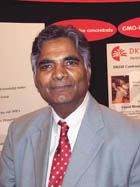
USDA licensed the rights to this gel made from fibrous waste to Circle Group Holdings Inc., an investment firm specializing in intellectual property. To commercialize the product, Circle Group launched FiberGel Technologies Inc., Mundelein, IL. Industry skepticism of claims for fat replacers led to the construction of a $5.5 million demonstration plant last year in suburban Chicago. The plant also serves as a platform for optimizing the production process under the direction of cereal chemist Triveni P. Shukla. Shukla began working with FiberGel in 2003 and assumed the position of vice president-technology development in December 2004. He also works with product development specialists to demonstrate how a gel made from fibrous waste can be used as a substitute for fat, gum and other stabilizers.
Shukla received a master's degree in chemical engineering in India, then moved to Urbana, IL, to work on his PhD in dairy technologies at the University of Illinois. He was head of R&D and engineering at Milwaukee-based Krause Milling Co. for 13 years before becoming a consultant to food processing companies. Shukla has worked in contract R&D, facility planning and other services for some of the leading global food and beverage companies, including Anheuser-Busch and ConAgra.
FE: Why might the third time be a charm for Inglett's fat replacers?
Shukla: The insoluble fiber present in the earlier products posed difficulties with absorption. This process literally results in an ingredient that is amorphous.
Five or six firms in the milling industry pooled money to develop Oatrim, which is made from oat flour that is partially hydrolyzed to become paste. Staley, ConAgra and others licensed it, and it went nowhere. It was very water absorptive, wasn't flavor neutral at low levels and tended to make dough sticky. Nu-Trim came next, but it didn't fare any better commercially. George kept going, developed a different process and patented Z-Trim. "Zero calories" is an impossible claim-some calories are needed for flavor. Nonetheless, it's 92 percent pure. Its contribution of calories is virtually zero.

Shukla: We are a technology deployment company, and originally we didn't plan to build a plant. But no food company is going to change a formula based on the claims of what might be a rinky-dink company. We had to optimize the process and make enough product to penetrate the market. You can make 3 to 4 lbs. of powder in a lab, but the R&D man is done when they ask for 50 lbs.
We can output one million lbs. of dry powder annually here, or about 50 million lbs. of gel. This is a jumbo, jumbo, jumbo pilot plant. We first created 300 lbs. of Z-Trim on June 6, 2003. The 5,000-gallon holding tanks in our facility could be scaled up to 50,000 gallons.
FE: What is the plant's development history?
Shukla: Originally a small contract manufacturer made product for us, and we learned what changes we'd have to make to boost efficiency. We then invested four months of hard work putting our plant together. Since the plant's grand opening in August 2004, we've added an ultrafiltration/reverse osmosis system to remove a glue extender from the waste stream. Before that, we were hauling wastewater away by truck, and the plant generates 36,000 gallons a day. The glue extender is a saleable product and constitutes about 17 percent of the waste. The Koch membrane system we installed has outstanding controls that automatically go into a CIP cycle if the membranes start to plug. The next step is to integrate the controls for all the process equipment.
FE: What are the essentials of the process?
Shukla: The first stage involves breaking down the fibers in a slurry of soluble and insoluble components. Fiber is a bundle of molecules; I want to unbundle it and separate the soluble and insoluble molecules.
Raw materials are heated with water in a stainless steel tank in the range of 85
